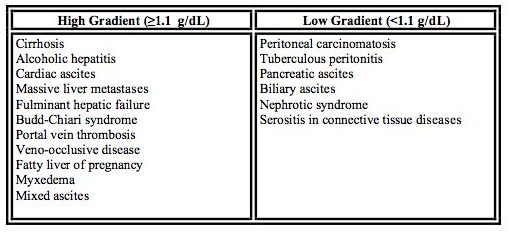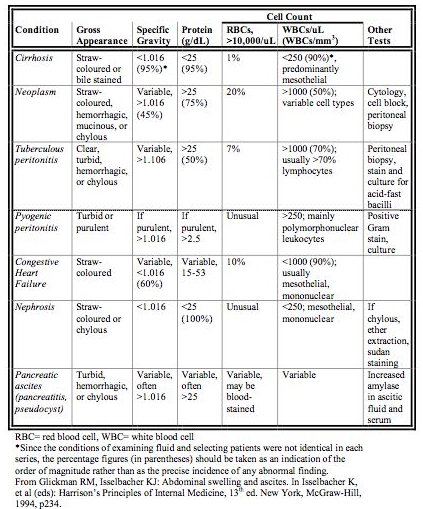Interpretation of Ascitic Fluid
Ascitic fluid should undergo gross inspection as well as laboratory analysis. Routine laboratory test include: differential cell count, albumin assay, and cultures. Please refer to the tables below for information on ascitic fluid characteristics in specific disease conditions. It is not required that you memorize the tables at this time, but you should be familiar with the general trends outlined.
Inspection
Ascitic fluid is typically translucent and yellow. Fluid of other colour or consistency may reflect specific underlying disease processes (see table).
Cell Count
Several millileters of ascitic fluid are sufficient to obtain a differential cell count.
Albumin
A serum-ascites albumin gradient (SAAG) can be obtained by simultaneous measurement of ascitic and serum-ascites albumin gradient. This is a useful test for the diagnoses of portal hypertension. The concept surrounds the oncotic-hydrostatic balance. The simple calculation is: SAAG= serum albumin - ascitic albumin.

Medicine, 4th ed. Pennsylvania, Elsevier, 2004, p 851-856.
Culture and Gram Stain
The most valuable method for determining the presence of infection is culture. The sensitivity of this test is markedly increased by the direct inoculation of blood culture bottles at the bedside. Approximately 10 bacteri/uL of fluid is required for a positive Gram stain. Thus, the Gram stain is insensitive in spontaneous bacterial peritonitis in which the medium concentration of bacteria is 10-3 organisms/uL of fluid. The Gram stain can only be expected to be helpful in cases of free gut perforation.
Miscellaneous
Optional tests include measurement of total protein, glucose, lactate dehydrogenase, and amylase. These will be beneficial in selected circumstances and need not be obtained on a routine basis.
Ascitic Fluid Characteristics in Various Disease States
